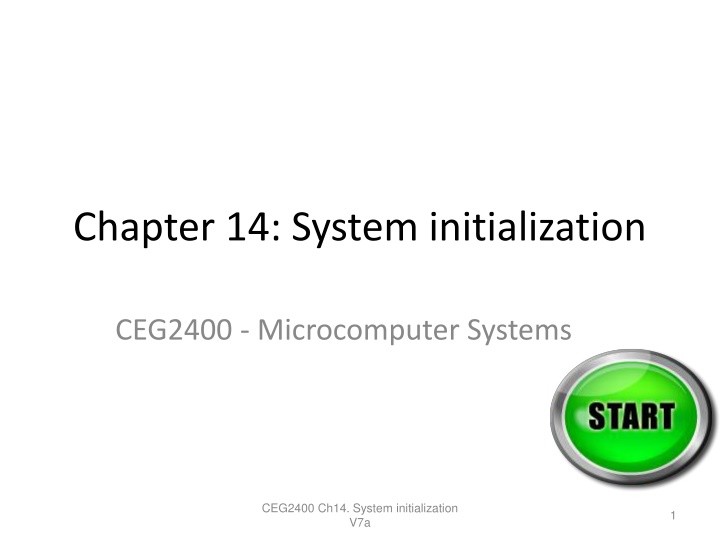
System Initialization in Microcomputer Systems - CEG2400 Chapter 14 Overview
Learn about system initialization in microcomputer systems with a focus on hardware components such as reset circuits, crystal oscillators, and phase-locked loops. Explore how reset circuits and codes work, memory space initialization, oscillator configurations, and synchronization using Phase Locked Loops (PLL). Understand the importance of proper initialization for efficient system operation.
Download Presentation

Please find below an Image/Link to download the presentation.
The content on the website is provided AS IS for your information and personal use only. It may not be sold, licensed, or shared on other websites without obtaining consent from the author. If you encounter any issues during the download, it is possible that the publisher has removed the file from their server.
You are allowed to download the files provided on this website for personal or commercial use, subject to the condition that they are used lawfully. All files are the property of their respective owners.
The content on the website is provided AS IS for your information and personal use only. It may not be sold, licensed, or shared on other websites without obtaining consent from the author.
E N D
Presentation Transcript
Chapter 14: System initialization CEG2400 - Microcomputer Systems CEG2400 Ch14. System initialization V7a 1
System Control Block Hardware initialization 1) Reset circuit, reset code 2) Crystal oscillator 3) Phase locked loop PLL A study of startup.s Memory space initialization CEG2400 Ch14. System initialization V7a 2
1) Reset Circuit, to begin oscillator After reset Run code at 0x0000 0000 CEG2400 Ch14. System initialization V7a 3
C13 is to keep reset-low for 10ms or more Reset Circuit #RESET goes low when you press SW1 Upon reset or powerup, ARM executes instruction at address 0x00000000 CEG2400 Ch14. System initialization V7a 4
Reset Code see startup.s AREA RESET, CODE, READONLY ARM LDR PC, Reset_Addr LDR PC, Undef_Addr ; DCD=Define Constant Data (same as DCW) Reset_Addr DCD Reset_Handler EXPORT Reset_Handler Reset_Handler ; initialise everything here Vectors CEG2400 Ch14. System initialization V7a 5
2) Oscillator Crystal + caps connected to XTAL1 and XTAL2 pins to generate a clock A square wave can also be input to XTAL1 We use 11.0592MHz because it is a multiple of the baud rates we wish to use for the UARTs (11.0592MHz=57600x192) http://thumbs.ebaystatic.com/ pict/270150155601_1.jpg CEG2400 Ch14. System initialization V7a 6
3) Phase locked loop (PLL) one chip two systems CEG2400 Ch14. System initialization V7a 7
One chip two systems Printed Circuit Board (PCB) cannot run too fast (11.0592 MHz) LPC213x internal can run faster (60MHz) PCB Oscillator 11.0592 MHz LPC213x Runs faster at 60MHz PCB runs slow CEG2400 Ch14. System initialization V7a 8
But there is a synchronization problem The solution is use a Phase Locked Loop PLL to lock the two frequencies. MCU LPC213x Fosc (11.0592MHz) Runs fasters 60MHz Mother board Printed Circuit Board (PCB) Runs slower 11.0592MHz CEG2400 Ch14. System initialization V7a 9
Phase locked loop High frequency signals (55.296Mhz) are difficult to handle on a PCB due to the relatively long wires used. This is less of a problem on-chip. We want a high frequency (55.296M) for high throughput, also we want a slow clock. frequency(11.0592MHz) for low power and less electromagnetic interference. Many chips use a low frequency external clock and multiply on-chip to address these issues The synchronization problem is handled by a phase locked loop (PLL) CEG2400 Ch14. System initialization V7a 10
PLL - how it works Feedback system used to multiply clock input clock frequency Output of the loop filter sets voltage to VCO so the two frequencies at the phase detector are exactly the same Once locked , Fout=N x Fin CEG2400 Ch14. System initialization V7a http://www.uoguelph.ca/~antoon/gadgets/pll/pll.html Source: 11
LPC21xx PLL PLL Connect PLL divider PLL Enable FOSC CCLK FCCO PLL Multiplier Current controlled oscillator CEG2400 Ch14. System initialization V7a 12
E.g. MCU PLL LPX213x Fosc (11.0592MHz) CCLK=55.296M input oscillator frequency =FOSC by M to give CCLK CCLK = FOSC x M To do this, it uses a Current Controlled Oscillator at frequency FCCO = FOSC x M x 2 x P 156MHz <FCCO <320MHz,10 M Hz <FOSC <25MHz Fcco-=221.184M example M=5 xM CCLK for MCU 55.296MHz FOSC 11.0592MHz CCLK P=2 Mx2xP CCLK/4=PCLK for peripherals 13.824MHz FCCO = 221.184MHz Divide by 4 CEG2400 Ch14. System initialization V7a 13
Summary of Clocks One oscillator generates two outputs CCLK, PCLK ARM-LPC213x FOSCx5=CCLK for MCU 55.296MHz FOSC 11.0592MHz MCU Internal use CCLK/4= PCLK = for peripherals 13.824MHz Peripherals use For interfacing CEG2400 Ch14. System initialization V7a 14
Config. Register: PLLCFG 0xE01F C084 CEG2400 Ch14. System initialization V7a 15
Formulas for M,P (e.g. M=5,P=2 ) recall that CCLK = FOSC x M= 11.0592MHz x 5=55.296MHz FCCO =P x(CCLK x 2)=2x55.296x2=221.184MHz Ranges FOSC :10-25MHz FCCO :156-320MHz Details see appendix CEG2400 Ch14. System initialization V7a 16
Setting M=5 and P=2 by PLLCFG (0xE01F C084) Choose desired FOSC and CCLK (CCLK must be integer multiple) Calculate M in range 1-32 (MSEL bits are M-1) Calculate P so that FCCO is in correct range (P must be 1,2,4 or 8. PSEL bits are P-1) PLLCFG at 0xE01F C084=0x24=01,00100b Select P=2, PSEL=01b Select M=5, MSEL=00100b CEG2400 Ch14. System initialization V7a 17
Exercise 14.1 Student ID: ___________,Date:_____________ Name: _____________________________ Why CCLK( Internal clock of MCU) is faster than Fosc (crystal Oscillator frequency) ?___________________________________ If the crystal Fosc is 10Mhz, M=5, what is CCLK:?______ PCLK:?_______ How to make CCLK and PCLK synchronized? ?____________________ CEG2400 Ch14. System initialization 18 V7a
Inside startup.s, PLL Definitions ; Phase Locked Loop (PLL) definitions PLL_BASE EQU 0xE01FC080 ; PLL Base Address PLLCON_OFS EQU 0x00 ; PLL Control Offset PLLCFG_OFS EQU 0x04 ; PLL Configuration Offset PLLSTAT_OFS EQU 0x08 ; PLL Status Offset PLLFEED_OFS EQU 0x0C ; PLL Feed Offset PLLCON_PLLE EQU (1<<0) ; PLL Enable PLLCON_PLLC EQU (1<<1) ; PLL Connect PLLCFG_MSEL EQU (0x1F<<0) ; PLL Multiplier PLLCFG_PSEL EQU (0x03<<5) ; PLL Divider PLLSTAT_PLOCK EQU (1<<10) ; PLL Lock Status ;// <e> PLL Setup ;// <o1.0..4> MSEL: PLL Multiplier Selection ;// <1-32><#-1> ;// <i> M Value ;// <o1.5..6> PSEL: PLL Divider Selection ;// <0=> 1 <1=> 2 <2=> 4 <3=> 8 ;// <i> P Value ;// </e> PLL_SETUP EQU 1 PLLCFG_Val EQU 0x00000024; What is M and P? What is FCCO? CCLK? CEG2400 Ch14. System initialization V7a 19
PLL startup code ; Setup PLL IF PLL_SETUP <> 0 LDR R0, =PLL_BASE MOV R1, #0xAA MOV R2, #0x55 So the PLLCFG is at PLL_BASE+ PLLCFG_OFS = 0xE01FC080+0x04 = 0xE01FC084 ; Configure and Enable PLL MOV R3, #PLLCFG_Val STR R3, [R0, #PLLCFG_OFS] MOV R3, #PLLCON_PLLE STR R3, [R0, #PLLCON_OFS] STR R1, [R0, #PLLFEED_OFS] STR R2, [R0, #PLLFEED_OFS] ; 0x24 CEG2400 Ch14. System initialization V7a 20
A study of startup.s Memory space initialization CEG2400 Ch14. System initialization V7a 21
Uvision3(IDE--Interactive Development Environment) and startup.s startup.s is generated automatically. Use debug/start to dis-assemble startup.s and see the machine code. CEG2400 Ch14. System initialization V7a 22
LPC213x :ROM base is R/O Base=0x0000 0000 RAM base is R/W base=0x4000 0000 AT Keil Flash/config_flash_tool CEG2400 Ch14. System initialization V7a 23
Overview for LPC213x memory Address RAM 8K: Data= Heap_base=0x4000 0489 0X4000 1FFFF 0x4000 0489 Stack= 0x4000 0488 0x4000 0000 ROM 32K: program 0x0000 7FFF 0x0000 0000 CEG2400 Ch14. System initialization V7a 24
Step1: Line 39-69 RAM space starts from 0x4000 0000 in LPC213x Init symbols Heap_base=0x4000 0489 Stack_top =0x4000 0488 Ram_base=0x4000 0000 User_stack Mode_USR EQU 0x10 Mode_FIQ EQU 0x11 Mode_IRQ EQU 0x12 Mode_SVC EQU 0x13 Mode_ABT EQU 0x17 Mode_UND EQU 0x1B Mode_SYS EQU 0x1F IRQ_stack I_Bit EQU 0x80 ; when I bit is set, IRQ is disabled F_Bit EQU 0x40 ; when F bit is set, FIQ is disabled UND_Stack_Size EQU 0x00000000 ; not used here SVC_Stack_Size EQU 0x00000008 ABT_Stack_Size EQU 0x00000000 ; not used here FIQ_Stack_Size EQU 0x00000000 ; not used here IRQ_Stack_Size EQU 0x00000080 USR_Stack_Size EQU 0x00000400 SVC_stack 0x4000 0000 ISR_Stack_Size EQU (UND_Stack_Size + SVC_Stack_Size + ABT_Stack_Size + \ FIQ_Stack_Size + IRQ_Stack_Size) CEG2400 Ch14. System initialization V7a 25
Step2 : line70-87 create RAM space for stack/heap AREA STACK, NOINIT, READWRITE, ALIGN=3 Stack_Mem SPACE USR_Stack_Size __initial_sp SPACE ISR_Stack_Size Stack_Top Assign space for stack and then heap It is at 0x40000000, see uvision/flash/config_fl ash_tool./linker R/W_base=0x400000 00 Heap is used for malloc (memory allocation) in C, 0 here you may change it Directive: SPACE=allocation of memory ;// <h> Heap Configuration ;// <o> Heap Size (in Bytes) <0x0-0xFFFFFFFF> ;// </h> Heap_Size EQU 0x00000000 AREA HEAP, NOINIT, READWRITE, ALIGN=3 __heap_base Heap_Mem SPACE Heap_Size __heap_limit CEG2400 Ch14. System initialization V7a 26
Exercise 14.2 The result Rams/Rom space for LPC213x Fill in ?___ 0x4000 0488 User_stack : size?________ Address : 0x4000 1FFF Heap_base=0x4000 0489 Stack_top =0x4000 0488 Ram_base=0x4000 0000 On chip ram (8K) IRQ_stack size?________ 0x4000 0000 : : SVC_stack Size ?_______ 0x4000 0000 0x0000 7FFF On chip Flash Rom (32K) For Code What are the sizes of the RAM for data excluding stacks? Ans:?__________________________ User program: Exception addresses=0x0000 0000 0x0000 0000 CEG2400 Ch14. System initialization V7a 27
Summary learned some important steps for setting up a microcontroller CEG2400 Ch14. System initialization V7a 28
Appendices CEG2400 Ch14. System initialization V7a 29
Appendix 1 Memory Mapping Modes Wish reset to be flexible download to flash (boot loader) execute our program in flash execute routine in RAM Need some way to map different portions of memory to the ARM exception vectors Memory mapping control determines source of this data CEG2400 Ch14. System initialization V7a 30
Memory Mapping modes CEG2400 Ch14. System initialization V7a 31
Memory mapping modes So how does the bootloader know to execute your code? CEG2400 Ch14. System initialization 32 V7a
Memory mapping modes 12KB boot block remapped to high memory so it is at the same address for devices with different flash sizes CEG2400 Ch14. System initialization V7a 33
After reset CEG2400 Ch14. System initialization V7a 34
Details Remapped area is 32 bytes (size of interrupt buffer area) Additional 32 bytes (to store constants for jumping beyond range of branch instruction) Total 64 bytes Same data can be read from both remapped and original locations CEG2400 Ch14. System initialization V7a 35
Boot loader Always runs after reset Allows programming of flash memory Low on P0.14 starts the in-system programming command handler (J3 inserted on our board) If high, looks for a valid user program and executes it P0.14 must be pulled high or low by external hardware CEG2400 Ch14. System initialization V7a 36
Valid user program Reserved ARM interrupt vector location (0x0000 0014) should contain the 2 s complement of the check-sum of the remaining interrupt vectors. i.e. checksum of all vectors is 0. CEG2400 Ch14. System initialization V7a 37
Material Covered So Far Memory system Organization, endianess, address space, alignment ARM instructions Condition flags, instruction pipeline, conditional execution, branches, data processing instructions, barrel shifter, immediate values, multiplication, load/store, addressing modes, block transfers, stacks and subroutines ARM assembly language Simple loops, subroutines, bit operations, pseudo instructions, macros Interfacing Driving loads, reset, RS232 transceivers, crystal oscillator Initialization Peripherals: GPIO, UART, PLL (software and hardware) CEG2400 Ch14. System initialization V7a 38
Appendix 2 Power on hardware internal Wakeup timer ensures everything is stable and ready before allowing instructions to execute When using external oscillator, RESET should be asserted for >10ms on powerup What is the RC time constant for the circuit in previous slide? CEG2400 Ch14. System initialization V7a 39
Appendix 3 Detailed example of setting PLL FOSC=11.0592 MHz requires CCLK = 55.296MHz M = CCLK / Fosc = 55.296M / 11.0592 M = 5. M - 1 = 4 will be written as PLLCFG[4:0] Value for P can be derived from P = FCCO / (CCLK x 2), FCCO must be 156-320 MHz. Assuming the lowest allowed frequency for FCCO = 156 MHz, P = 156 MHz / (2 x 55.296 MHz) = 1.41... The highest FCCO frequency criteria produces P = 2.8935 Only solution for P that satisfies both of these requirements and is listed in Table 20 is P = 2. Therefore, PLLCFG[6:5] = 1 will be used. CEG2400 Ch14. System initialization V7a 40
PLLCON CEG2400 Ch14. System initialization V7a 41
PLLFEED Incorrect programming of the PLL will cause the uC to operate incorrectly The PLL is only updated if a PLLFEED sequence is received Update PLLCFG & PLLCON registers Write 0xAA to PLLFEED Write 0x55 to PLLFEED CEG2400 Ch14. System initialization V7a 42
PLLSTATUS ( PLLSTAT_OFS ) CEG2400 Ch14. System initialization V7a 43
PLL Definitions ; Phase Locked Loop (PLL) definitions PLL_BASE EQU 0xE01FC080 ; PLL Base Address PLLCON_OFS EQU 0x00 ; PLL Control Offset PLLCFG_OFS EQU 0x04 ; PLL Configuration Offset PLLSTAT_OFS EQU 0x08 ; PLL Status Offset PLLFEED_OFS EQU 0x0C ; PLL Feed Offset PLLCON_PLLE EQU (1<<0) ; PLL Enable PLLCON_PLLC EQU (1<<1) ; PLL Connect PLLCFG_MSEL EQU (0x1F<<0) ; PLL Multiplier PLLCFG_PSEL EQU (0x03<<5) ; PLL Divider PLLSTAT_PLOCK EQU (1<<10) ; PLL Lock Status ;// <e> PLL Setup ;// <o1.0..4> MSEL: PLL Multiplier Selection ;// <1-32><#-1> ;// <i> M Value ;// <o1.5..6> PSEL: PLL Divider Selection ;// <0=> 1 <1=> 2 <2=> 4 <3=> 8 ;// <i> P Value ;// </e> PLL_SETUP EQU 1 PLLCFG_Val EQU 0x00000024; CEG2400 Ch14. System initialization V7a 44 What is M and P? What is FCCO? CCLK?
PLL startup code ; Setup PLL IF PLL_SETUP <> 0 LDR R0, =PLL_BASE MOV R1, #0xAA MOV R2, #0x55 ; Configure and Enable PLL MOV R3, #PLLCFG_Val STR R3, [R0, #PLLCFG_OFS] MOV R3, #PLLCON_PLLE STR R3, [R0, #PLLCON_OFS] STR R1, [R0, #PLLFEED_OFS] STR R2, [R0, #PLLFEED_OFS] ; 0x24 CEG2400 Ch14. System initialization V7a 45
Wait until ready & switch ; Wait until PLL Locked PLL_Loop LDR R3, [R0, #PLLSTAT_OFS] ANDS R3, R3, #PLLSTAT_PLOCK BEQ PLL_Loop ; Switch to PLL Clock MOV R3, #(PLLCON_PLLE:OR:PLLCON_PLLC) STR R3, [R0, #PLLCON_OFS] STR R1, [R0, #PLLFEED_OFS] STR R2, [R0, #PLLFEED_OFS] ENDIF ; PLL_SETUP CEG2400 Ch14. System initialization V7a 46
VPB Clock Processor uses CCLK and peripherals use PCLK (peripherals usually don t run as fast as the processor) VPB divider determines relation between them Startup code doesn t change the default of / 4 What is PCLK in our system? See next slide CEG2400 Ch14. System initialization V7a 47
Answer : PLL setup of startup code* FOSC= 11.0592MHz PLLCFG_Val = 0x24 MSEL=4 (M=MSEL+1=5) CCLK= M * Fosc=55.296MHz P PSEL=1 i.e. P=2 (low) P= 156 MHz / (2 x 55.296 MHz) =1.41 (high) P= 320 MHz / (2 x 55.296 MHz) =2.89 PCLK=CCLK/4=13.824MHz (/4 is by default) PLLSTATUS ( PLLSTAT_OFS ) Psel =2 Msel =4 Bit | 6 5 | 4 0| CEG2400 Ch14. System initialization V7a 48





